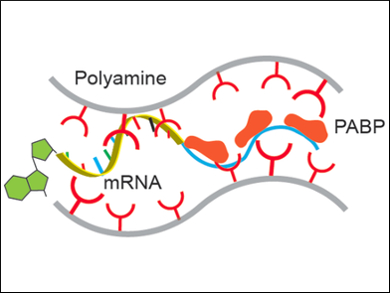Messenger RNA (mRNA) has become an increasingly important agent for gene-based therapies and vaccines. While numerous nanocarriers have been developed for mRNA delivery, the labile nature of mRNA results in a very low transfection efficiency (the introduction of foreign DNA into cells) and, thus, in poor expression of desired protein.
Paula T. Hammond, Massachusetts Institute of Technology (MIT), Cambridge, USA, and colleagues propose that one of the barriers to successful mRNA transfection is the fact that the synthetic mRNA with a poly A tail group must form a bound complex with a “helper” protein, known as poly A binding protein (PABP), after it is released in the cytoplasm. The scientists have pre-assembled such an mRNA–protein complex and packaged it with a polycation that can enhance the binding or clustering of the mRNA with PABP (pictured).
This strategy causes a 20-fold increase in mRNA expression in vitro and an approximately fourfold increase in mice. Besides potential clinical applications in mRNA-based therapeutics, the results suggest a set of new design principles for gene delivery by the synergistic co-assembly of mRNA with helper proteins.
- Polyamine-Mediated Stoichiometric Assembly of Ribonucleoproteins for Enhanced mRNA Delivery,
Jiahe Li, Yanpu He, Wade Wang, Connie Wu, Celestine Hong, Paula T. Hammond,
Angew. Chem. Int. Ed. 2017.
DOI: 10.1002/anie.201707466




